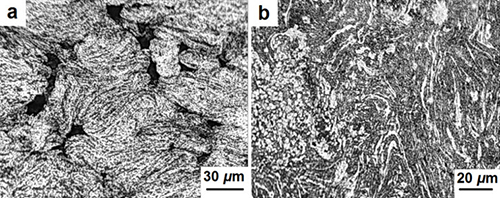Oxide Dispersion-Strengthened (ODS) Steels: Part Two
Abstract
Oxide dispersion strengthened (ODS) steels are under scrutiny for a number of reasons but one of the main applications for which they are promising are in-core structural materials for sodium fast reactors.
The key is the material density which gives rise to superior high temperature creep strength and good irradiation resistance.
Oxide dispersion-strengthened 13Cr-2Mo powder steel with the chemical composition shown in Table 1 was successfully consolidated to near-theoretical density using high voltage electric discharge compaction. More details are shown in paper of I. Bogachev et al.

Table 1: Chemical composition of the investigated steel powder
Cylindrical samples with relative density from 90% to 97% and dimensions of 10 mm in diameter and 10–15 mm in height were obtained. It was found that high pressures lead to better interparticle contacts and to the decreasing resistivity of these contacts. This, in turn, leads to the lower energy release and heating of the powder which affects the sintering consolidation mechanism. It is clear that, using high pressures, it is possible to compact samples to high density values only by cold plastic deformation mechanisms; however, the strength and hardness of such samples may be insufficient.
Therefore, it is necessary to combine both mentioned mechanisms to obtain an acceptable product. As a result, 200 MPa and 4.2 kV consolidation conditions were chosen as optimal for the compaction of ODS steel powder. A slight increase of the microhardness at the edges of the samples in the axial and radial directions was observed. During electric discharge, the powder areas located in the vicinity of the punches can densify more intensively due to a higher degree of plastic deformation in comparison with the central parts of the processed specimens.
Another reason for this effect may be associated with the high heating and cooling rates of these areas. No correlation between density and microhardness distribution in the volume of the processed samples was observed. This may be due to the fact that different factors independently affect the microhardness and density of the samples.
It was shown that the edges of the samples adjacent to the punches have a martensitic structure due to rapid cooling in these areas (see Figure 1). A different structure was observed at the edges adjacent to the side surface of the processed samples. It is a mixture of ferrite and perlite with a distance between the perlite plates of around 1–2 µm. This structure could be formed as a result of the intensive cooling of the side surface of the samples, but not as rapidly as in the locations of the martensitic phase. In general, high voltage compaction is an acceptable method for the consolidation of ODS steels.
This ultra-rapid process allows obtaining high density compacts, retaining the initial structure with minimal grain growth, and avoiding thermally activated phase transformations. Nevertheless, some heterogeneity of the structure may occur in the boundary layers of the processed samples due to thermal and electromagnetic effects. Therefore, the choice of the optimal parameters of consolidation is required for obtaining samples of acceptable quality.

Figure 1: Microstructure of the edge (a) and side surface (b) of the consolidated samples
Oxide dispersion strengthened (ODS) steels have drawn wide attention as a promising candidate in-core structural materials for a sodium fast reactor (SFR) due to their superior high temperature creep strength and good irradiation resistance to a void swelling under a neutron irradiation environment. Nano-sized oxide particles with a high number density may act as pinning points to dislocation movement or sinks for irradiation induced defects.
The work of T.K.Kim et al. explores the possibility ODS steels for SFR reactor at the Korea Atomic Energy Research Institute (KAERI). R & D on ODS steels consists of mainly 3 tasks; (1) ODS steel composition, (2) fabrication technology of ODS steel cladding tube, and joining technology of ODS steel cladding tube. As a result, advanced ODS steel has been developed, and this material was named as the advanced radiation resistant ODS steel (ARROSTM). Representative composition of the ARROS is (in wt%) Fe-10Cr-1Mo-0.5Mn-0.1V-0.25Ti-0.35Y2O3.
ARROS has been designed on the basis of a martensitic phase with consideration of the high homogeneity, productivity and reproducibility. Cr and Mo are the most important elements to determine the matrix phase of ODS steels. On the basis of the out-of-pile performance tests such as tensile and creep at 700°C, microstructural observation and ion irradiation, the Cr and Mo contents were optimized to be 10% and 1%, respectively. Our ODS steel containing 10% Cr has a typical tempered martensitic structure with fine needle-like grains and grain boundary carbides. The addition of solid-solution hardening elements such as Mo usually acts to the improvement of strength.
However, an excessive addition of Mo leads to form the brittle phase, called as Laves phase on the prior austenite grain and lath boundaries as well as the coarsened carbides under high-temperature stress conditions exposed to a neutron irradiation environment. Therefore, the content of Mo was controlled to be 1 wt% to enhance the long-term creep property in ARROS. Several minor alloying elements such as Mn, Ti, and V could also be added to improve the various characteristics of ARROS. Mn could serve to increase the strength of a matrix by the martensitic strengthening as austenite-forming elements and contents could be 0.01 to 1 wt% for Mn. Previous works on the chemical compositions of oxide particle in ODS steels showed that the addition of a small amount of Ti resulted in decreasing the particle size and increasing the number density and consequently improving the high temperature creep strength.
Seguir leyendo
¡Encuentre al Instante Miles de Diagramas de Metalografía!
Total Materia Horizon contiene una colección única de imágenes de metalografía de una amplia gama de aleaciones metálicas, países, normas y tratamientos térmicos.

Obtenga una cuenta de prueba GRATUITA de Total Materia Horizon y únase a nuestra comunidad que traspasa los 500.000 usuarios provenientes de más de 120 países.